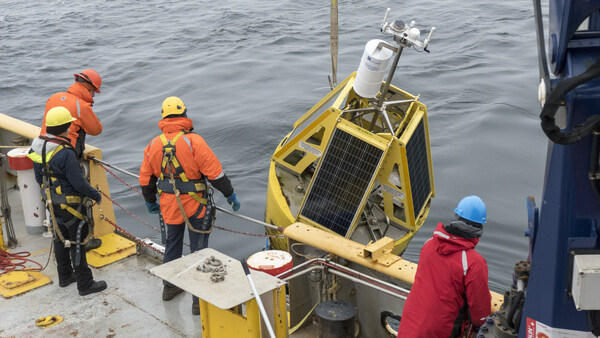Rimouski, QC – The unique world-class MARS station operated by the Institut des sciences de la mer (ISMER) of the Université du Québec à Rimouski (UQAR), Innovation maritime and Multi-Électronique has exceeded expectations since its first deployment at the bottom of the Laurentian Channel. It has allowed to establish the acoustic signature of 250 vessels, to better understand the origin of noise on board ships, and to put forward initiatives aimed at minimizing their impact on marine mammals in the St. Lawrence.
Since 2021, four buoys equipped with twelve underwater hydrophones have been deployed at depths of up to 350 metres offshore Rimouski in the spring, and recovered the following autumn, to measure the noise emitted in the St. Lawrence by ships navigating in the seaway.
Entitled MARS, this project involves about fifteen people, as well as the participation of Multi-Électronique and OpDAQ Systèmes, and four partner shipowners: Desgagnés, CSL, Fednav and Algoma.
“The MARS project has enabled us to develop cutting-edge expertise in the design and manufacture of instrumentation and in the processing of ship acoustic signatures, and has also led to the training of several researchers and highly qualified personnel,” says ISMER-UQAR Director Guillaume St-Onge.
“The research station has proved its worth and has become an essential tool for understanding the marine soundscape of the St. Lawrence and the noise emitted by ships in order to limit their impact on marine wildlife such as whales. In fact, the station’s data are currently being used in the development of national limits of underwater noise reduction targets for ships.”
Since the station was set up, the team has carried out 17 missions aboard partner vessels to perform vibration diagnostics.
“This work makes it possible to estimate the respective contribution of each piece of equipment on board, such as pumps, generators and engines, to the noise signature of ships. Such information is useful for targeting various technologies to reduce the noise impact of ships,” explains Sylvain Lafrance, Director of Innovation maritime. “In particular, the use of potentially noise-reducing paint will be tested and acoustic resonators that reduce certain frequencies of noisy machinery are being tested to reduce the impact of ship noise on the marine environment.”
Sound travels four times faster in water than in air, and hearing is an essential sense for marine mammals, fish and invertebrates to communicate, feed and move in the water.
“The importance of the St. Lawrence River means that everyone needs to work together to develop sustainable marine shipping solutions for Canada, and the world. With government, industry, and academia, through the MARS project, we can better understand the impact of underwater noise generated by vessel traffic. And most importantly, this research means that we can find solutions for our environment and endangered marine mammals”, says the Minister of Transport, Pablo Rodriguez.
The partners’ ship noise mitigation research and testing will continue until next spring, as will collaboration with European teams involved in the PIAQUO (Practical Implementation of Achieve Quiet Oceans) project. The partners are pursuing their efforts to continue operating the station. With a budget of over 5.7 M$, the MARS project was financially supported by Transport Canada and the Ministère de l’Économie, de l’Innovation et de l’Énergie du Québec, in addition to shipowners Desgagnés, CSL, Fednav, Algoma and the Société de développement économique du Saint-Laurent.
(UQAR photo of MARS project)





